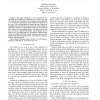Free Online Productivity Tools
i2Speak
i2Symbol
i2OCR
iTex2Img
iWeb2Print
iWeb2Shot
i2Type
iPdf2Split
iPdf2Merge
i2Bopomofo
i2Arabic
i2Style
i2Image
i2PDF
iLatex2Rtf
Sci2ools
ICRA
2005
IEEE
2005
IEEE
Behavior-Grounded Representation of Tool Affordances
Abstract— This paper introduces a novel approach to representing and learning tool affordances by a robot. The tool representation described here uses a behavior-based approach to ground the tool affordances in the behavioral repertoire of the robot. The representation is learned during a behavioral babbling stage in which the robot randomly chooses different exploratory behaviors, applies them to the tool, and observes their effects on environmental objects. The paper shows how the autonomously learned affordance representation can be used to solve tool-using tasks by dynamically sequencing the exploratory behaviors based on their expected outcomes. The quality of the learned representation was tested on extensionof-reach tool-using tasks.
| Added | 25 Jun 2010 |
| Updated | 25 Jun 2010 |
| Type | Conference |
| Year | 2005 |
| Where | ICRA |
| Authors | Alexander Stoytchev |
Comments (0)

